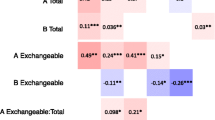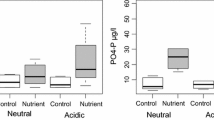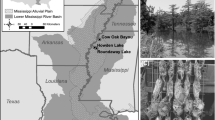Abstract
Riparian zones are an important transition between terrestrial and aquatic ecosystems, and they function in nutrient cycling and removal. Non-native earthworms invading earthworm-free areas of North America can affect nutrient cycling in upland soils and have the potential to affect it in riparian soils. We examined how the presence of earthworms can affect riparian nutrient cycling and nutrient delivery to streams. Two mesocosm experiments were conducted to determine how (1) the biomass of earthworms and (2) earthworm species can affect nutrient flux from riparian zones to nearby streams and how this flux can affect streamwater nutrients and periphyton growth. In separate experiments, riparian soil cores were amended with one of four mixed earthworm biomasses (0, 4, 10, or 23 g m−2 ash-free dry mass) or with one of three earthworm species (Aporrectodea caliginosa, Lumbricus terrestris, L. rubellus) or no earthworm species. Riparian soil cores were coupled to artificial streams, and over a 36-day period, we measured nutrient leaching rates, in-stream nutrient concentrations, and periphyton growth. Ammonium leaching increased with increasing biomass and was greatest from the A. caliginosa treatments. Nitrate leaching increased through time and increased at a greater rate with higher biomass and from cores containing A. caliginosa. We suggest that the overall response of increased nitrate leaching [90% of total nitrogen (N)] was due to a combination of ammonium excretion and burrowing by earthworms, which increased nitrification rates. During both experiments, periphyton biomass increased through time but did not differ across treatments despite high in-stream inorganic N. Through time, in-stream phosphorus (P) concentration declined to <5 μg l−1, and periphyton growth was likely P-limited. We conclude that activities of non-native earthworms (particularly A. caliginosa) can alter biogeochemical cycling in riparian zones, potentially reducing the N-buffering capacity of riparian zones and altering stoichiometric relationships in adjacent aquatic ecosystems.







Similar content being viewed by others
References
Alban DH, Berry EC (1994) Effects of earthworm invasion on morphology, carbon, and nitrogen of a forest soil. Appl Soil Ecol 1:243–249
APHA (1999) Standard methods for the examination of water and wastewater, 20th edn. Port City Press, Baltimore
Bernhardt ES, Likens GE, Buso DC, Driscoll CT (2003) In-stream uptake dampens effects of major forest disturbance on watershed nitrogen export. Proc Natl Acad Sci USA 100:10304–10308
Bohlen PJ, Parmelee RW, Blair JM, Edwards CA, Stinner BR (1995) Efficacy of methods for manipulating earthworm populations in large-scale field experiments in agroecosystems. Soil Biol Biochem 27:993–999
Bohlen PJ, Pelletier DM, Groffman PM, Fahey TJ, Fisk MC (2004a) Influence of earthworm invasion on redistribution and retention of soil carbon and nitrogen in northern temperate forests. Ecosystems 7:13–27
Bohlen PJ, Scheu S, Hale CM, McLean MA, Migge S, Groffman PM, Parkinson D (2004b) Non-native invasive earthworms as agents of change in northern temperate forests. Front Ecol Environ 2:427–435
Bouché MB (1977) Strategies lombriciennes. Ecol Bull 25:122–132
Burtelow AE, Bohlen PJ, Groffman PM (1998) Influence of exotic earthworm invasion on soil organic matter, microbial biomass and denitrification potential in forest soils of the northeastern United States. Appl Soil Ecol 9:197–202
Chin YP, Aiken G, Oloughlin E (1994) Molecular-weight, polydispersity, and spectroscopic properties of aquatic humic substances. Environ Sci Technol 28:1853–1858
Curry JP, Schmidt O (2007) The feeding ecology of earthworms—a review. Pedobiologia 50:463–477
Darwin CR (1881) The formation of vegetable mould, through the action of worms, with observations on their habitats. John Murray, London
Davies PE, Nelson M (1994) Relationships between riparian buffer widths and the effects of logging on stream habitat, invertebrate community composition and fish abundance. Aust J Mar Freshw Res 45:1289–1305
Davis CA, Austin JE, Buhl DA (2006) Factors influencing soil invertebrate communities in riparian grasslands of the central Platte River floodplain. Wetlands 26:438–454
Domínguez J, Bohlen PJ, Parmelee RW (2004) Earthworms increase nitrogen leaching to greater soil depths in row crop agroecosystems. Ecosystems 7:672–685
Edwards CA (2004) Earthworm ecology, 2nd edn. CRC Press, Boca Raton
Gold AJ, Jacinthe PA, Groffman PM, Wright WR, Puffer RH (1998) Patchiness in groundwater nitrate removal in a riparian forest. J Environ Qual 27:146–155
Gregory SV, Swanson FJ, McKee WA, Cummins KW (1991) An ecosystem perspective of riparian zones. Bioscience 41:540–551
Grimm NB, Gergel SE, McDowell WH, Boyer EW, Dent CL, Groffman PM, Hart SC, Harvey JW, Johnston CA, Mayorga E, McClain ME, Pinay G (2003) Merging aquatic and terrestrial perspectives of nutrient biogeochemistry. Oecologia 137:485–501
Groffman PM, Gold AJ, Simmons RC (1992) Nitrate dynamics in riparian forests: microbial studies. J Environ Qual 21:666–671
Groffman PM, Bohlen PJ, Fisk MC, Fahey TJ (2004) Exotic earthworm invasion and microbial biomass in temperate forest soils. Ecosystems 7:45–54
Hale CM, Reich PB, Frelich LE (2004) Allometric equations for estimation of ash-free dry mass from length measurements for selected European earthworm species (Lumbricidae) in the Western Great Lakes region. Am Midl Nat 151:179–185
Hale CM, Frelich LE, Reich PB (2005a) Exotic European earthworm invasion dynamics in northern hardwood forests of Minnesota, USA. Ecol Appl 15:848–860
Hale CM, Frelich LE, Reich PB, Pastor J (2005b) Effects of European earthworm invasion on soil characteristics in Northern hardwood forests of Minnesota, USA. Ecosystems 8:911–927
Hale CM, Frelich LE, Reich PB, Pastor J (2008) Exotic earthworm effects on hardwood forest floor, nutrient availability and native plants: a mesocosm study. Oecologia 155:509–518
Harwood JE, Kühn AL (1970) A colorimetric method for ammonium in natural waters. Water Res 4:805–811
Hedin LO, von Fisher JC, Ostrom NE, Kennedy BP, Brown MG, Robertson GP (1998) Thermodynamic constraints on nitrogen transformations and other biogeochemical processes at soil-stream interfaces. Ecology 79:684–703
Hendrix PF (1995) Earthworm ecology and biogeography in North America. Lewis, Boca Raton
Holdsworth AR, Frelich LE, Reich PB (2007) Regional extent of an ecosystem engineer: earthworm invasion in northern hardwood forests. Ecol Appl 17:1666–1677
House GJ, Parmelee RW (1985) Comparison of soil arthropods and earthworms from conventional and no-tillage agroecosystems. Soil Tillage Res 5:351–360
Howarth RW, Billen G, Swaney D, Townsend A, Jaworski N, Lajtha K, Downing JA, Elmgren R, Caraco N, Jordan T, Berendse F, Freney J, Kudeyarov V, Murdoch P, Zhu ZL (1996) Regional nitrogen budgets and riverine N&P fluxes for the drainages to the North Atlantic Ocean: natural and human influences. Biogeochemistry 35:75–139
Jones CG, Lawton JH, Shachak M (1994) Organisms as ecosystem engineers. Oikos 69:373–386
Keller RP, Cox AN, Van Loon C, Lodge DM, Herborg L-M, Rothlisberger J (2007) From bait shops to forest floor: earthworm use and disposal by anglers. Am Midl Nat 158:321–328
Knollenberg WG, Merritt RW, Lawson DL (1985) Consumption of leaf litter by Lumbricus terrestris (Oligochaeta) on a Michigan woodland floodplain. Am Midl Nat 113:1–6
Lamberti GA, Resh VH (1985) Comparability of introduced tiles and natural substrates for sampling lotic bacteria, algae and macroinvertebrates. Freshw Biol 15:21–30
Lamberti GA, Gregory SV, Ashkenas LR, Steinman AD, McIntire CD (1989) Productive capacity of periphyton as a determinant of plant-herbivore interactions in streams. Ecology 70:1840–1856
Ligthart TN, Peek GJCW (1997) Evolution of earthworm burrow systems after inoculation of lumbricid earthworms in a pasture in the Netherlands. Soil Biol Biochem 29:453–462
Lowrance T, Todd RL, Fail J, Hendrickson O, Leonard R, Asmussen L (1984) Riparian forests as nutrient filters in agricultural watersheds. Bioscience 34:274–377
McCarthy EL (1934) Mariotte’s bottle. Science 80:100
McClain ME, Boyer EW, Dent CL, Gergel SE, Grimm NB, Groffman PM, Hart SC, Harvey JW, Johnston CA, Mayorga E, McDowell WH, Pinay G (2003) Biogeochemical hot spots and hot moments at the interface of terrestrial and aquatic ecosystems. Ecosystems 6:301–312
Naiman RJ, Décamps H, McClain ME (2005) Riparia: ecology, conservation, and management of streamside communities. Elsevier, Burlington
Parkin TB, Berry EC (1999) Microbial nitrogen transformations in earthworm burrows. Soil Biol Biochem 31:1765–1771
R Development Core Team (2006) R: A language and environment for statistical computing. R Foundation for Statistical Computing, Vienna, Austria. ISBN: 3-900051-07-0. Available at: URL: http://www.R-project.org/
Rappoldt C (1993) Modelling the geometry of worm burrow systems in relation with oxygen diffusion. Geoderma 57:69–88
Reynolds JW (1977) The earthworms (Lumbricidae and Sparganophilidae) of Ontario. Royal Ontario Museum, Toronto
Robertson GP, Wedin D, Groffman PM, Blair JM, Holland EA, Nadelhoffer KJ, Harris D (1999) Soil carbon and nitrogen availability: nitrogen mineralization, nitrification, and soil respiration potentials. In: Robertson GP, Coleman DC, Bledsoe CS, Sollins P (eds) Standard soil methods for long-term ecological research. Oxford University Press, New York, pp 258–271
Rosemond AD (1993) Interactions among irradiance, nutrients, and herbivores constrain a stream algal community. Oecologia 94:585–594
Sabater S, Butturini A, Clement J.-C, Burt T, Dowrick D, Hefting M, Maître V, Pinay G, Postolache C, Rzepecki M, Sabater F (2003) Nitrogen removal by riparian buffers along a European climatic gradient: patterns and factors of variation. Ecosystems 6:20–30
Sala OE, Chapin FS III, Armesto JJ, Berlow R, Bloomfield J, Dirzo R, Huber-Sanwald E, Huenneke LF, Jackson RB, Kinzig A, Leemans R, Lodge DM, Mooney HA, Oesterheld M, Poff NL, Sykes MT, Walker BH, Walker M, Hall DH (2000) Global biodiversity scenarios for the year 2100. Science 287:1770–1774
Scheu S (1987) The influence of earthworms (Lumbricidae) on the nitrogen dynamics in the soil litter system of a deciduous forest. Oecologia 72:197–201
Scheu S, Schlitt N, Tiunov AV, Newington JE, Jones TH (2002) Effects of the presence and community composition of earthworms on microbial community functioning. Oecologia 133:254–260
Schlesinger WH (1997) Biogeochemistry: an analysis of global change, 2nd edn. Academic Press, San Diego
Shuster WD, Shipitalo MJ, Subler S, Aref S, McCoy EL (2003) Earthworm additions affect leachate production and nitrogen loses in typical Midwestern agroecosystems. J Environ Qual 32:2132–2139
Singer AC, Jury W, Luepromchai E, Yahng C-S, Crowley DE (2001) Contribution of earthworms to PCB bioremediation. Soil Biol Biochem 33:765–776
Steinman AD, Lamberti GA, Leavitt PR (2006) Biomass and pigments of benthic algae. In: Hauer FR, Lamberti GA (eds) Methods in stream ecology, 2nd edn. Academic Press, San Diego, pp 357–379
Strauss EA, Mitchell NL, Lamberti GA (2002) Factors regulating nitrification in aquatic sediments: effects of organic carbon, nitrogen availability, and pH Canadian. J Fish Aquat Sci 59:463–554
Suárez ER, Pelletier DM, Fahey TJ, Groffman PM, Bohlen PJ, Fisk MC (2004) Effects of exotic earthworms on soil phosphorus cycling in two broadleaf temperate forests. Ecosystems 7:28–44
Suárez ER, Fahey TJ, Yavitt JB, Groffman PM, Bohlen PJ (2006) Patterns of litter disappearance in a Northern hardwood forest invaded by exotic earthworms. Ecol Appl 16:154–165
Tiunov AV, Scheu S (2004) Carbon availability controls the growth of detritivores (Lumbricidae) and their effects on nitrogen mineralization. Oecologia 138:83–90
Turner JS (2000) The extended organism: the physiology of animal-built structures. Oxford University Press, Cambridge
United States Department of Agriculture (USDA), Soil Survey Staff, Natural Resources Conservation Service (2007) Web soil survey. Available at: http://websoilsurvey.nrcs.usda.gov/. Accessed 11 Jan 2008
Whalen JK, Parmelee RW, Subler S (2000) Quantification of nitrogen excretion rates for three lumbricid earthworms using 15N. Biol Fertil Soils 32:347–352
Zorn MI, van Gestel CAM, Eijackers H (2005) Species-specific earthworm population responses in relation to flooding dynamics in a Dutch floodplain soil. Pedobiologia 49:189–198
Zorn MI, Van Gestel CAM, Morrien E, Wagenaar M, Eijackers H (2008) Flooding responses of three earthworm species, Allolobophora chlorotica, Aporrectodea caliginosa, and Lumbricus rubellus, in a laboratory-controlled environment. Soil Biol Biochem 40:587–593
Acknowledgments
We thank LE Kinsman, JM Dreyer, J Frentress, M Stephen, JH Larson, KJ Kulacki, MJ Michel, and MA Brueseke for assistance with the experiments and sample processing. D Birdsell, J Loftus, and L Fuchs provided valuable support at the University of Notre Dame Center for Environmental Science and Technology. LE Kinsman, SD Tiegs, SD Bridgham, and two anonymous reviewers provided helpful comments on this manuscript. Funding was provided by the National Science Foundation via the Integrated Systems for Invasive Species (ISIS) project (www.math.ualberta.ca/~mathbio/ISIS). Additional funding to DMC was provided by an UNDERC Fellowship, a Sigma ** Grant-In-Aid of Research Award, a Bayer Predoctoral Fellowship, and a North American Benthological Society President’s Award. Experiments performed for this study comply with U.S. laws.
Author information
Authors and Affiliations
Corresponding author
Additional information
Communicated by Stefan Scheu.
Rights and permissions
About this article
Cite this article
Costello, D.M., Lamberti, G.A. Non-native earthworms in riparian soils increase nitrogen flux into adjacent aquatic ecosystems. Oecologia 158, 499–510 (2008). https://doi.org/10.1007/s00442-008-1149-0
Received:
Accepted:
Published:
Issue Date:
DOI: https://doi.org/10.1007/s00442-008-1149-0




